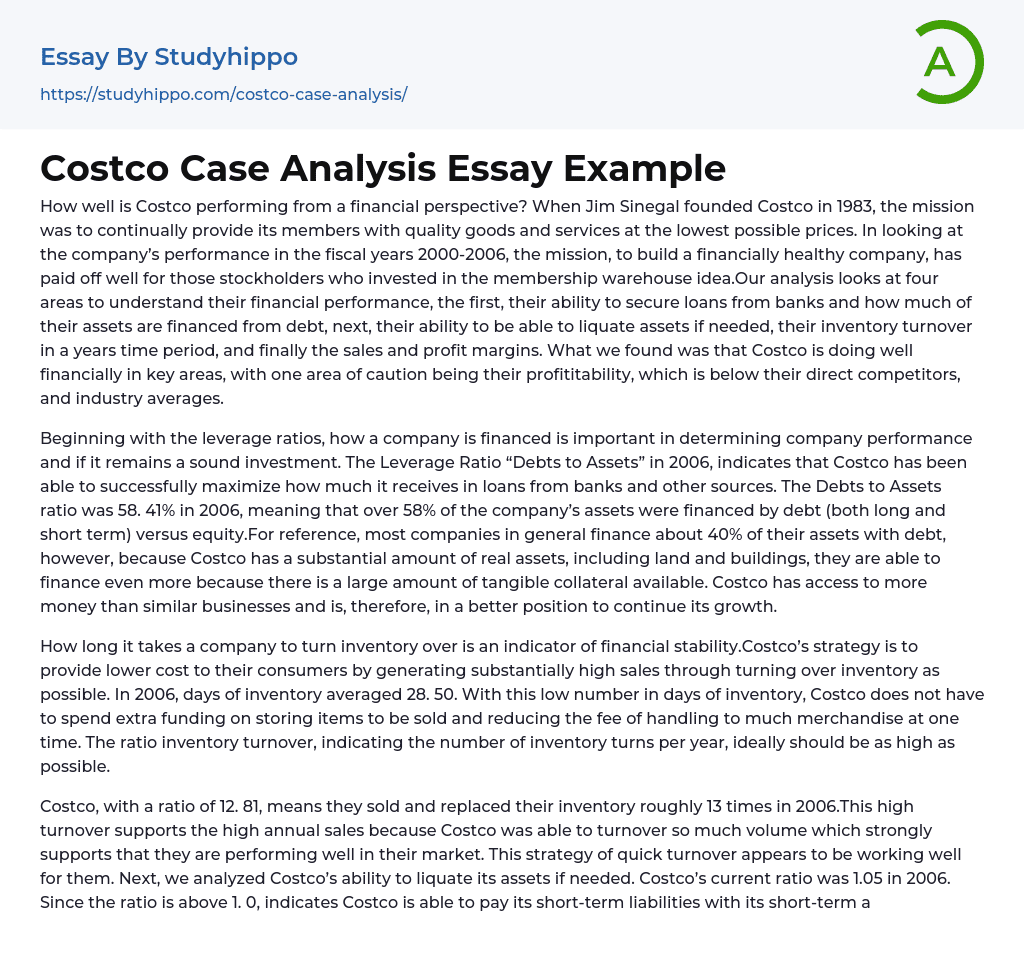When Jim Sinegal founded Costco in 1983, the goal was to consistently offer quality goods and services to members at the lowest possible prices. Evaluating the company's performance in fiscal years 2000-2006 reveals that this mission has been successful in establishing a financially stable company, benefiting stockholders who invested in the membership warehouse concept. Our analysis focuses on four aspects to comprehend their financial performance. Firstly, their capacity to obtain loans from banks and the extent to which their assets are financed through debt. Secondly, their ability to liquidate assets if necessary. Thirdly, their inventory turnover within a year. Lastly, their sales and profit margins.
Costco is financially thriving in certain aspects, but there are concerns about their profitability compared to direct competitors and industry averages. The company's financing plays a crucial role in as
...sessing its performance and investment potential. By examining leverage ratios, we can gain insights into this aspect. In 2006, Costco's debt-to-assets ratio indicated successful maximization of loans from banks and other sources, standing at 58.41%. This means that over 58% of the company's assets were financed through debt rather than equity (both long and short term). It is worth noting that most companies typically finance around 40% of their assets through debt. However, due to Costco's substantial tangible collateral like land and buildings, they are able to finance even more. This provides them with greater access to funds compared to similar businesses, positioning them favorably for future growth.
Costco's financial stability can be gauged by the duration it takes to sell its inventory. The company strives for lower prices through a fast turnover of inventory. In 2006, Costco had an average inventory
turnover of 28.50 days. This demonstrates that Costco does not need extra resources for storing unsold products, effectively reducing handling costs associated with excess merchandise.
The ideal inventory turnover ratio should be as high as possible, indicating the number of inventory turns per year. In 2006, Costco had a ratio of 12.81, meaning they sold and replaced their inventory approximately 13 times. This high turnover supports their high annual sales, as it shows that Costco was able to quickly sell a large volume of inventory. This suggests that they are performing well in their market, indicating that their strategy of quick turnover is successful.
In addition, we evaluated Costco's capacity to liquidate its assets in case of necessity. In 2006, Costco's current ratio stood at 1.05. This ratio being above 1.0 signifies that Costco can settle its short-term obligations using its short-term assets. Conversely, a ratio lower than 1.
0 typically indicates that a company is not able to turn its assets into liquid cash fast enough to pay its debtors. In 2006, Costco had a working capital of $413,000, indicating that the company has funds available to pay its liabilities promptly and expand without borrowing money. Additionally, it suggests that Costco has minimal funds tied up in its inventory and outstanding customer payments. This level of working capital reflects the efficiency of Costco in maximizing sales and collecting payments. However, it is important to note that Costco's working capital in 2006 was significantly lower than the $1,477,000 in 2005.
The significant decrease in capital could raise concerns for potential investors as it suggests a decline in sales and smaller accounts receivable. However, this decrease is due to Costco's
expansion efforts in 2005 and 2006. Despite expanding annually, Costco remains financially stable, indicating positive financial liquidity. On the downside, one aspect that stands out is Costco's profitability valuation. Compared to the retail industry and the S;P 500, Costco's profit margins (gross, operating, and net) are significantly lower. Costco's net profit margin, or net return on sales, was only 1%.
In 2006, Costco had a return on stockholders' equity (ROE) of 12.06%, which is considered sluggish compared to the industry average of roughly 7%. This indicates that Costco's performance in terms of ROE was less than half of the industry average for that year. The book's average ROE range of 12-15% does not fully demonstrate this significant difference.
- Money essays
- Financial Accounting essays
- Market Segmentation essays
- Supply And Demand essays
- Purchasing essays
- Forecasting essays
- Legacy essays
- Bank essays
- Corporate Finance essays
- Financial News essays
- Financial Ratios essays
- Financial Services essays
- Free Market essays
- Shareholder essays
- Personal finance essays
- Equity essays
- Financial Crisis essays
- Banking essays
- Credit Card essays
- Currency essays
- Debt essays
- Gold essays
- Loan essays
- Enron Scandal essays
- Foreign Exchange Market essays
- Investment essays
- Venture Capital essays
- Stock Market essays
- Retirement essays
- Donation essays
- Net Present Value essays
- Income Statement essays
- Commercial Bank essays
- Debit Card essays
- Deposit Account essays
- Subprime Lending essays
- Perfect Competition essays
- Underwriting essays
- Synergy essays
- Valuation essays
- Investing essays
- Asset essays
- Depreciation essays
- Discounted Cash Flow essays
- Foreign Direct Investment essays
- Funds essays
- Internal Rate Of Return essays
- Revenue essays
- Day Trading essays
- Futures Trading essays




